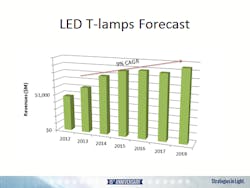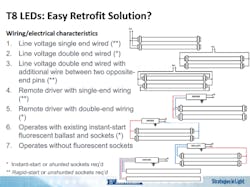As many of you know, last week the Strategies Unlimited team was at Strategies in Light to present data and help out with the proceedings and trade floor.
During my presentation, I went over the forecast that SU has created for LED fluorescent tube replacement. My view of the market for these lamps is quite bearish, with the CAGR from 2013 to 2018 only 9%.
I mentioned that while the installed base for fluorescent lamps is huge and only second to that of incandescent lamps, LED tube lamps are not likely to penetrate this market on a large scale due to several factors, including:
- The benefits that fluorescent tubes already have
- Long life
- Low price
- Efficient
- The unwillingness of site managers to change
- The abundance of T-12 installations still on the market as a prime example
- The difficulty of finding and installing the right LED tube
Interestingly, after I gave my presentation, I moderated a session where Naomi Miller, a designer and scientist at the Pacific Northwest National Laboratory, compared different LED fluorescent tube replacements. The slide that stood out to me the most listed the seven different ways that these LED tubes had to be installed, based on their design, which to me is a very negative selling point for these lamps.
Whereas anybody can go buy any replacement fluorescent brand as long as it fits in the socket, purchasers of these LED tubes have to limit themselves to either the same brand, or at least one that has the exact same setup. The implications this brings up are huge:
- What if the company you are buying these lamps from goes out of business?
- What if the lamp itself is redesigned?
- You cannot mix and match retrofits throughout a building, as safety concerns would come into play with the different wiring schemes.
Couple this with the difficulty of matching specific lamp setups with the different kinds of troffers, and you have an even harder decision to make.
I know that this can be a contentious opinion for some, and this is not to say that there won’t be an LED tube market. However, it is important to realize that just because you can make a better light, it does not mean that it will automatically be installed.








